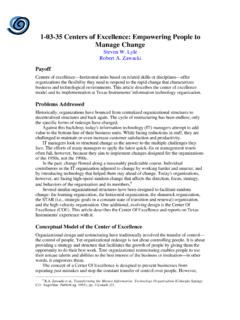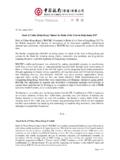Transcription of Supply Chain Cost-Cutting Strategies - Percon
1 Supply Chain Cost-Cutting Strategies How Top Process Industry Performers Take Radically Different Actions March 2007 Underwritten, in Part, by Winning Supply Chain Strategies for Process Industries All print and electronic rights are the property of Aberdeen Group 2007. Aberdeen Group i Executive Summary Companies in the Process Industries (including chemicals, pharmaceuticals, food & bev-erage, oil & gas, pulp & paper, and health & beauty aides) have had to cope with rising manufacturing and logistics costs over the past few years. To avoid a increase in logistics costs (what the average company has experienced in the past two years), com-panies should follow the roadmap of Best in Class companies, which have been able to reduce costs or keep them flat via Supply Chain transformation. In the face of the steady run up in manufacturing and logistics costs, the old Strategies for cost containment no longer have the same punch.
2 Companies in the process industries now widely realize that they must restructure their Supply chains to take out costs and maintain their customer service edge. Aberdeen s survey found that 75% of all respon-dents have either recently redesigned or are in the process of redesigning their Supply chains. Best in Class s Enormous Performance Advantage The study found a tremendous gap between Best in Class organizations and their peers. Best in Class companies have a to 9X advantage in improving their key perform-ance metrics since 2005, including improving perfect order percentages and lowering Supply Chain costs. In addition, the Best in Class have better absolute performance. They are twice as likely as their peers to have: Forecast accuracy at the product family level of 71% or better Perfect order percentage of 91% or better Logistics costs as a % of sales of 6% or less To achieve these enormous advantages over their peers, they have taken radically differ-ent actions in organization structure and Supply Chain technology investment.
3 As a result, Best in Class companies are much further ahead in closed-loop integration of Supply Chain planning and execution, in addition to data and process visibility across their end-to-end Supply Chain and from plant floor to top floor. Recommendations for Action Companies should evaluate their operations and supporting technology to ensure they effectively accomplish the following: Centralize key elements of the Supply Chain management organization. Work toward end-to-end data and process visibility throughout the Supply Chain to improve utilization of manufacturing capacity and distribution efficiencies. Move to more frequent inventory policy review (multiple times a year) and im-prove ability to sense changes in customer demand (aim for five days or less). Upgrade Supply Chain applications and move to a closed-loop planning and execution technology framework. Winning Supply Chain Strategies for Process Industries All print and electronic rights are the property of Aberdeen Group 2007.
4 Aberdeen Group Table of Contents Executive Summary .. i Chapter One: Issue at 1 cost Challenges Coming from All 1 Supply Chain Reinvention Is Happening Now .. 2 Barriers to Transformation Success .. 2 Top Supply Chain Transformation Goals for 2007 .. 3 Chapter Two: Key Business Value Findings .. 4 The Best in Class 4 What the Best in Class Do Differently .. 6 Case Study: Basic American Foods Drives Performance with Visibility .. 6 Best in Class Centralize Their Supply Chain 7 Best in Class Are Ahead in Inventory and Demand Review .. 7 Case Study: Inventory Optimization Pays Off for Chemical Producer .. 7 Manufacturing Transformation Priorities for 2007 .. 8 Case Study: Sunsweet Growers Improves Production Efficiency and Redesigns Its Distribution Network .. 8 Logistics Transformation Priorities for 2007 .. 9 Case Study: BASF Discovers the Value of Improved Logistics Visibility . 9 Chapter Three: Implications & Analysis.
5 10 Best in Class Overwhelmingly More Likely to Use Technology .. 10 Case Study: Degussa Cuts Inventory and Improves Customer Service 11 Best in Class: Technology and Process 12 Case Study: Manufacturer Dynamically Reconfigures Supply Chain .. 12 Traceability Technology: An Emerging Imperative .. 12 Chapter Four: Recommendations for Action .. 13 Laggard Steps to 15 Industry Average Steps to Success .. 15 Best in Class Next Steps .. 16 Featured Underwriters .. 17 Appendix A: Research 20 Appendix B: Related Aberdeen Research & Tools .. 21 Winning Supply Chain Strategies for Process Industries All print and electronic rights are the property of Aberdeen Group 2007. Aberdeen Group Figures Figure 1: Process Industries Are Actively Reinventing Their Supply Chains .. 2 Figure 2: Best in Class Have Advantage in Performance Improvements5 Figure 3: Best in Class Have Much Better Absolute Supply Chain Performance . 5 Figure 4: Best in Class Are 3X-5X More Likely to Have Achieved Closed-Loop Integration, Visibility, and Centralization.
6 6 Figure 5: Supply Chain Management Emerges as a Competitive Differentiator. 13 Tables Table 1: Top Supply Chain Enhancement Plans for 3 Table 2: Best in Class Adopt More Technology to Drive Supply Chain Improvement .. 11 Table 3: Competitive Framework for Process Industries .. 14 Winning Supply Chain Strategies for Process Industries All print and electronic rights are the property of Aberdeen Group 2007. Aberdeen Group 1 Chapter One: Issue at Hand Key Takeaways 75% of the process industry companies Aberdeen surveyed have either restructured or are planning to restructure their Supply chains this year. 66% of respondents say Supply Chain restructuring is being driven by a need to contain Supply Chain costs in order to remain competitive in the marketplace. Supply Chain redesigns are required to address and contain manufacturing and logistics costs. rocess industries, which include chemicals, pharmaceuticals, food & beverage, oil & gas, pulp & paper, and health & beauty aides, have confronted an inexorable escalation in Supply Chain costs the past few years.
7 Yet companies still expect their Supply chains to restrain those costs and perform at stellar levels. Aberdeen s survey of executives in the process industries found just how tough those cost pressures have become in their Supply chains. We re maintaining an expected 99% service level while reducing overall costs, says one food and beverage executive. Study results show markedly different approaches by those companies able to control Supply Chain costs effectively and those that continue to struggle. These differences are most extreme in how these companies use technology and organize their Supply Chain operations. Appendix A shows the demographics of survey respondents, which were bro-ken out evenly across the major process industry categories. cost Challenges Coming from All Sides Supply chains face sundry cost pressures today. Fifty percent of survey respondents say that manufacturing costs have been paramount in driving up Supply Chain costs.
8 Fully 44% cite transportation cost pressures, and an equal number also point at escalating cus-tomer service requirements. Rising energy prices, which impact manufacturing and transportation costs, are an especially large culprit for many process industries, cited by 38%. Other factors include the cost of supporting more specialty products to fight com-moditization, labor and insurance costs, and regulatory and security compliance costs (especially hazmat, FDA, REACH, HIPAA, etc.). Companies in the process industries have struggled to hold the line on logistics costs. The survey found that 82% of respondents have seen logistics cost increases since 2005, with the weighted average increase being a cost hike. (Logistics costs are measured as warehouse, transportation, and inventory costs as a percentage of sales.) P Winning Supply Chain Strategies for Process Industries All print and electronic rights are the property of Aberdeen Group 2007.
9 2 AberdeenGroup Supply Chain Reinvention Is Happening Now The top reason that process industry companies are focusing on Supply Chain transforma-tion are these cost pressures, followed by escalating customer service demands and the restructuring requirements brought on by the increase in process industry acquisition and divesture activity. In response to these pressures, companies have either redesigned or begun to redesign their Supply chains. Three-quarters of study participants have begun work on that challenge (Figure 1). Figure 1: Process Industries Are Actively Reinventing Their Supply Chains Source: AberdeenGroup, March 2007 The old Strategies for cost containment lack the same punch they once had, and in par-ticular, companies are finding that traditional functional-based improvement approaches are no longer adequate. Moreover, increasing reliance on external Supply Chain partners also requires companies to rethink traditional approaches.
10 Global business demands are also causing many process industry companies to transform their Supply chains. A new inclusion of lower- cost suppliers around the world is our biggest hurdle, reports a midsize pharmaceutical manufacturer. Barriers to Transformation Success Although a majority of survey respondents have embarked on the challenge of Supply Chain re-engineering, a number of survey participants say they face both internal and ex-ternal obstacles in transforming their Supply Chain . They cite such factors as labor and materials Supply constraints, the shear size of their enterprise, the inability to focus on change rather than fire fighting, and finally, even resistance of management. Supply Chain redesigns clearly require effort and vision from top management to overcome these challenges. Our siloed organization approach is our biggest barrier, says an executive in the chemical and oil & gas industries.





